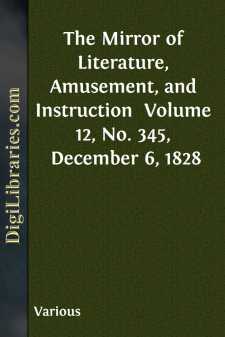Categories
- Antiques & Collectibles 13
- Architecture 36
- Art 48
- Bibles 22
- Biography & Autobiography 813
- Body, Mind & Spirit 142
- Business & Economics 28
- Children's Books 15
- Children's Fiction 12
- Computers 4
- Cooking 94
- Crafts & Hobbies 4
- Drama 346
- Education 46
- Family & Relationships 57
- Fiction 11828
- Games 19
- Gardening 17
- Health & Fitness 34
- History 1377
- House & Home 1
- Humor 147
- Juvenile Fiction 1873
- Juvenile Nonfiction 202
- Language Arts & Disciplines 88
- Law 16
- Literary Collections 686
- Literary Criticism 179
- Mathematics 13
- Medical 41
- Music 40
- Nature 179
- Non-Classifiable 1768
- Performing Arts 7
- Periodicals 1453
- Philosophy 64
- Photography 2
- Poetry 896
- Political Science 203
- Psychology 42
- Reference 154
- Religion 513
- Science 126
- Self-Help 84
- Social Science 81
- Sports & Recreation 34
- Study Aids 3
- Technology & Engineering 59
- Transportation 23
- Travel 463
- True Crime 29
The Mirror of Literature, Amusement, and Instruction Volume 12, No. 345, December 6, 1828
by: Various
Categories:
Description:
Excerpt
The Arch of Constantine, at Rome.
"Still harping" on the Fine Arts—Architecture and Painting. Of the former, the above engraving is an illustration; and of the latter, our readers will find a beautiful subject (from one of Turner's pictures) in a Supplement published with the present Number.
The Arches of Rome were splendid monuments of triumph, erected in honour of her illustrious generals. They were at first very simple, being built of brick or hewn stone, and of a semicircular figure; but afterwards more magnificent, built of the finest marble, and of a square figure, with a large, arched gate in the middle, and two small ones on each side, adorned with columns and statues. In the vault of the middle gate, hung winged figures of victory, bearing crowns in their hands, which, when let down, they placed on the victor's head, when he passed in triumph.
The Arch of Constantine, the most noble of all of these structures, subsists almost entire. It was erected by the senate and Roman people, in honour of Constantine, after his victory over Maxentius, and crosses the Appian Way, at the junction of the Coelian and Palatine Hills. Here it stands as the last monument of Roman triumph, or like the December sun of "the world's sole monument."
This building consists of three arches, of which the centre is the largest; and has two fronts, each adorned with four columns of giallo antico marble, of the Corinthian order, and fluted, supporting a cornice, on which stand eight Dacian captives of Pavonazzetta, or violet-coloured marble.
The inscription on both sides of the architrave imports, that it was dedicated "to the Emperor Cæsar Flavius Constantine Augustus, the greatest, pious, and the happy; because by a divine impulse, the greatness of his courage, and the aid of his army, he avenged the republic by his just arms, and, at the same time, rescued it from the tyrant and his whole faction." On one side of the arch are the words, "Liberatori urbis," to the deliverer of the city; and on the other, "Fundatori quietis," to the founder of public tranquillity.
Although erected to the honour of Constantine, this arch commemorates the victories of Trajan, some of the basso-relievos, &c. having been pilfered from one of the arches of Trajan. This accounts for the Dacian captives, whose heads Lorenzo de Medicis broke off and conveyed to Florence, but the theft might not have been so notorious to posterity, had not the artists of Constantine's time added some figures of inferior merit. Forsyth says, "Constantine's reign was notorious for architectural robbery;" and the styles of the two emperors, in the present arch, mar the harmony by their unsightly contrasts.
Although the decree for erecting this arch was, without doubt, passed immediately after the defeat of Maxentius, it appears from the monument itself, that the building was not finished and dedicated till the tenth year of Constantine's reign, or the year of Christ 315 or 316.
The newly-erected arch opposite the entrance to Hyde Park is from the Roman arch, though, we believe, not from any particular model....












